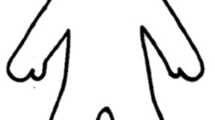Abstract
College students, 107 females and 57 males, were asked to give single-word or phrase responses to four questions about the “worst thing” a member of each sex can call a member of the same or the opposite sex. The resulting 134 different words and phrases were sorted into seven categories by peer raters and a series of chi-square analyses were performed. With minor exceptions, no sex differences in responses were found, but highly significant differences were found in insults attributed to and by the two sexes. For example, insults referring to sexual looseness were said to be directed almost exclusively toward women, and those referring to homosexuality almost exclusively toward men, but only by other men. Results suggest that male and female college students agree on some stereotypic differences between men and women in the giving and receiving of verbal attack.
Similar content being viewed by others
References
Ardener, S. G. Sexual insult and female militancy. Man: The Journal of the Royal Anthropological Institute of Great Britain and Ireland, 1973, 8 (3), 422–440.
Bodine, A. Sex differentiation in language. In B. Thorne & N. Henley (Eds.), Language and sex: Differentiation and dominance. Rowley, MA: Newbury House, 1975.
Bradley, P. H. The folk-linguistics of women's speech: An empirical examination. Communication Monographs, 1981, 48 (1), 73–90.
Conklin, N. F. Toward a feminist analysis of linguistic behavior. University of Michigan Papers in Women's Studies, 1974, 1 (1), 51–73.
Coyne, J. C., Sherman, R. C., & O'Brien, K. Expletives and women's place. Sex Roles: A Journal of Research, 1978, 4(5), 827–835.
Firestone, S. The dialectic of sex. New York: William Morrow, 1970.
Flexner, S. B. Preface. In H. Wentworth & S. B. Flexner (Eds.), Dictionary of American slang. New York: Thomas Y. Crowell Co., 1960.
Gilley, H. M., & Collier, S. S. Sex differences in the use of hostile verbs. Journal of Psychology, 1970, 76, 33–37.
Gregersen, E. Sexual linguistics. Annals of the New York Academy of Science, 1979, 327, 3–19.
Hoenigswald, H. M. A proposal for the study of folk-linguistics. In W. Bright (Ed.), Sociolinguistics. The Hague: Mouton, 1966.
Jesperesen O. Language: Its nature, development and origin. London: Allen & Unwin, 1922.
Kalenius, W. G., Jr. Connotative meaning as a function of sex, intelligence, and class placement. Dissertation Abstracts, 1967, 27(9-A), 2887–2888.
Key, M. R. Male/female language. Metuchen, NJ: Scarecrow Press, 1975.
Kramer, C. Women's speech: Separate but unequal. Quarterly Journal of Speech, 1974, 60(1), 14–24. (a)
Kramer, C. Folklinguistics. Psychology Today, June 1974, 82–85. (b)
Kramer, C., Thorne, B., & Henley, N. Perspectives on language and communication. Signs, 1978, 3,(3), 638–651.
Labov, W. Sociolinguistic patterns. Philadelphia: University of Pennsylvania Press, 1972.
Lakoff, R. Language and woman's place. New York: Harper, 1975.
Partridge, E. (Ed.) A dictionary of slang and unconventional English, 8th ed. New York: Macmillan, 1984.
Rosenau, N. Sex differences in ideal self-concepts. Unpublished manuscript, University of Southern California, Andrus Gerontology Center, Los Angeles, 1974.
Sargent, A. G. Beyond sex roles. St. Paul, MN: West Publishing Company, 1977.
Silverstein, A., & Dienstiber, R. A. Rated pleasantness and association value of 101 English nouns. Journal of Verbal Learning and Verbal Behavior, 1968, 7(1), 81–86.
Spears, R. A. (Ed.) Slang and euphemism: A dictionary of oaths, curses, insults, sexual slang, drug talk, homosexual lingo, and related matters. Middle Village, NY: Jonathan Daird Publishers, 1981.
Stanley, J. P. Paradigmatic woman: The prostitute. In D. L. Shores (Ed.), Papers in language variation. Birmingham: University of Alabama Press, 1977.
Taylor, B. A. Toward a structural and lexical analysis of swearing and language of abuse in Australian English. Linguistics, 1975, N164, 17–43.
Thorne, B., Kramarae, C., & Henley, N. (Eds.) Language, Gender and Society. Rowley, MA: Newbury House Publishers, 1983.
Walsh, R. H., & Leonard, W. M. Usage of terms for sexual intercourse by men and women. Archives of Sexual Behavior, 1974, 3(4), 373–376.
Author information
Authors and Affiliations
Additional information
We wish to thank those who assisted in various ways: Ric Dias, Cynara Doe, Michael Levine, Rochelle Dias, Steve Penning, Debbie Carrier, Deanne Anderson, Peter Buss, Dave Carter, Mike Penley, Nancy Soncrant, Cindy Stout, and especially Debbie Harrison.
Rights and permissions
About this article
Cite this article
Preston, K., Stanley, K. “What's the worst thing...?” gender-directed insults. Sex Roles 17, 209–219 (1987). https://doi.org/10.1007/BF00287626
Issue Date:
DOI: https://doi.org/10.1007/BF00287626




